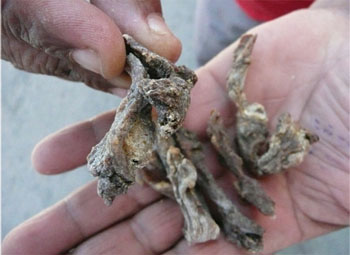10.2.5 Drying
This is a dehydration process by which the water/moisture content of the food is removed or decreased. Pathogenic and other bacteria cannot multiply in the absence of water. Most tend to die in foods that have been dehydrated to a moisture content of 10–20% of weight. Drying, however, may not kill spores. Drying also achieves food preservation by inactivating enzymes.
Drying or evaporation methods have been applied to nearly every kind of watery food, including milk. Although the loss in vitamins and nutritional value is usually minor, some foods change physically and chemically, and are sometimes altered in natural colour and flavour. Other dried products do not compare favourably with their fresh counterparts due to difficulties in reconstitution, i.e. adding water to return the food to its original form. One traditional form of dried food is quanta (Figure 10.4). Quanta is made from sliced meat which is hung in the air to dry.

10.2.4 The use of low temperature
